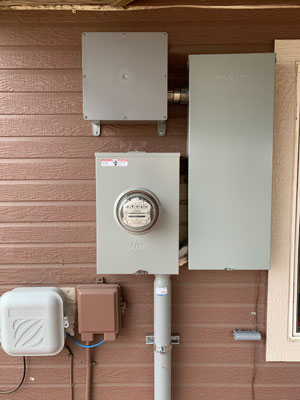
A power distribution system is used in every residential house or bunglow, commercial and industrial building. In the residential power distribution system, power is distributed to the house through a service entrance. Service in reference to electricity is the facility of electric power provided by the utility company for commercial and domestic purpose. Entrance is the entry point from where electric power enters the house. The incoming power supply is connected to this equipment, which provides a means to control and cut off the supply in an emergency
How distribute load to each room it is essential to understand. load centre is the point from where an activity or process of electrical appliance can be controlled. The electric power distribution network, installed in our houses, is an example of residential power distribution system. Electric power from a substation enters the house through a metering device called energy meter. The incoming power then goes to a residential control panel or load centre. This load centre provides circuit control and overcurrent protection. From there, power is distributed. to various rooms of the house through branch circuits. These branch circuits include lighting circuit, electrical and electronic appliances
Parts of load centre- A load centre can be a single panel or a group of panels that can be assembled to form a single panel. A load centre includes a busbar, circuit protection devices, equipped switches for the control of light, fan, machinery, power circuit, etc. A load centre as single unit in a cabinet or enclosure can be mounted on the wall and can be accessible only from the front. The busbar serves as a common connection for two or more circuits Power leaves the load centre through a phase or live wire(s) of a circuit. Then it operates electrical devices, such as light bulb, fan, etc. The electrical current returns to the load centre through the neutral circuit wire, usually black in colour, which is connected to the neutral busbar. The bar is connected to the load centre and returns the current back to the electric utility grid
Load centres are divided into two, main breaker load centre and main lug load centre, on the basis of circuit breaker use in the load centre.
Main breaker load centre-Load centres have a number of circuit breakers, but, a large circuit breaker is placed at the top This main breaker can disconnect the power of the entire house, if the overall load rises too high or if there is another serious problem in the electrical system. Usually, these problems involve momentary power fluctuations, such as due to lightning or thunder in the rainy season.
Main lug load centre- While the main breaker load centre uses a main circuit breaker, the main lug load centre does not have a main circuit breaker. The incoming supply cables are connected directly to the main lugs and busbars This type of load centre has no primary overload protection. So, it is not used in houses or industries as a first entering load centre. It is used as a distribution load centre. Therefore, it Place for is a secondary load centre that is used in further branch circuit distribution of electricity within the house or the industry. Main lug load centres are sometimes referred to as add-on, secondary or downstream panels. These panels are added when all circuit slots in the main breaker load centre are full or when a remote panel is required For example, a main breaker load centre might supply power to a main lug load centre located in an area of the house used as a workshop. Main lug load centres are also fed from metering equipment when used in apartment installations.
Full rating- In this method, all the circuit breakers including the main and branch circuit breakers must have a rating equal to or greater than the available fault current. For example, in case of a building using the full rating method, it will have every circuit protection device rating at, at least, 22,000 amperes.
Series rating- In this method, the main circuit protection device must have a rating equal to or greater than the fault current of the system. The subsequent circuit protection devices connected in the series can be rated at lower values. For example, the main circuit protection device must have a rating of 22,000 amperes, which is equal to or greater than the fault current of the system, but the subsequent circuit protection device must have 10,000 amperes, which is at a lower value
Earthing- earthing means connecting the metallic part of a machine that does not carry current under normal conitions to the earth. it is done for the protection of electrical equipment and to provide a least resistive path from the equipment to the earth. Earthing is to ensure safety or protection of electrical equipment and humans by discharging electrical energy to the earth.